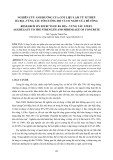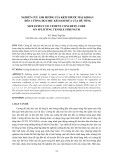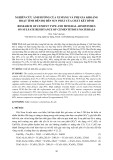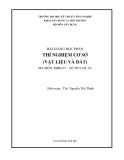
Journal of Science and Transport Technology Vol. 3 No. 2, 11-18
Journal of Science and Transport Technology
Journal homepage: https://jstt.vn/index.php/en
JSTT 2023, 3 (2), 11-18
Published online 30/06/2023
Article info
Type of article:
Original research paper
DOI:
https://doi.org/10.58845/jstt.utt.2
023.en.3.2.11-18
*Corresponding author:
E-mail address:
quynhanhbt@utt.edu.vn
Received: 05/06/2023
Revised: 26/06/2023
Accepted: 28/06/2023
Evaluation of shear bond for double-layer
asphalt based on shear test
Quynh-Anh Thi Bui1*, Joon Seo Lee2, Thai Quang Kieu1
1University of Transport Technology, Hanoi 100000, Vietnam
2Billzone Co. Ltd., Seoul 01000, South Korea
Abstract: Asphalt concrete pavement often appears damaged such as rutting,
fatigue crack, potholes, etc. at high air temperature, heavy rain in long time, or
at locations with high traffic, large horizontal force, and poor-quality
construction sites. This causes a deterioration in the service quality, leading to
a lot of maintenance costs. These failures are often related to bond between
layers of asphalt concrete. Therefore, this paper shows the evaluation results
of shear bond of double-layer asphalt (with tack coat rate of 0, 0.2, 0.5, 0.8
l/m2) based on shear test at the experimental temperatures (25, 40, 60oC),
normal pressure (0, 0.14, 0.2, 0.4, 0.6 MPa). The results show that, when the
temperature increases from 25oC to 60oC, the shear bond between the asphalt
layers decreases sharply. At 25oC, the average shear bond that tested with
normal pressure of 0.6 MPa increases by 52.19% compared to that tested at
pressure of 0 MPa. When the temperature reaches 60oC, the average shear
bond that tested with normal pressure 0.6 MPa increases by 94.87% compared
to that tested at 0 MPa pressure. At 25°C, non-tack coat samples have lowest
shear bond. However, at 40oC and 60oC, the shear bond of 0.8 l/m2 tack coat-
based samples reach the lowest value. At the same time, a regression equation
between shear bond and input variables proposed by Minitab V17 software
provides high reliability results.
Keywords: Shear bond, double-layer, asphalt, shear test, tack coat.
1. Introduction
Currently, the flexible pavement structure is
designed in multiple layers by different materials.
Good bond between different layers of asphalt
concrete (AC) for the purpose of ensuring the unity
features of the pavement structure [1]. The design
and construction standards of asphalt concrete
pavements in Vietnam do not pay much attention
to the degree of bond between AC layers. Some
structural design assumptions still assume that the
layers are completely bonded [2]. Moreover, the
construction process of AC layers only specifies
about the bond between two layers that is
evaluated by qualitative observation of the field
coring [3]. It can be seen that there has not been
quantified in terms of experimental method. Thus,
the bond quality related to the shear resistance of
the flexible pavement structure is completely
evaluated qualitatively. Studies to provide a
quantitative method as well as the required shear
bond strength value of double-layer AC sample
have been carried out in the US and some
European countries from the 90s to the present [4-
7].
Obviously, the factors affecting the shear
bond properties between AC layers play an
important role, determining the bond strength for
AC pavement in general [8]. Some factors affecting

JSTT 2023, 3 (2), 11-18
Bui et al
12
the shear bond between asphalt concrete layers
have been studied including factors of tack coat
material (type, ratio, and curing time) [6,7,9],
surface properties of the interface [5,7,10,11],
characteristics of the concrete sample and mixture
[5,12], and in-process parameters [13-16]. Some
factors that greatly affects the shear bond of
double-layer AC sample are the tack coat
application rate, the test normal pressure and
temperature. According to Mohammad et al. [7],
Canestrari et al. [6], Romanoschi and Metcalf [5],
too little tack coat will not ensure the bonding,
however too much tack coat will lead to slippage
between layers. Shear bond usually reaches its
highest value when tack coat rate is optimal. The
studied tack coat rates are usually in range of 0-1.0
l/m2. According to Canestrari et al. [4], West et al.
[11], Hachiya et al. [9], temperature is the most
influential factor on shear bond because the
properties of bituminous material depend much on
temperature. When the temperature increases
from 15-60°C, the shear bond of the tack coat-
based interface will decrease sharply. In addition,
Chen and Huang [13], Uzan [16], Canestrari [4],
West [11], evaluated the shear bond by shear test
under some normal pressure levels (0 - 0.6 MPa).
The results show that growth of normal pressure
increases the shear bond of the interface layer. At
high temperatures, the shear bond is strongly
dependent on the normal pressure. In Vietnam,
some authors have also studied a number of
factors affecting the shear bond resistance
between AC layers such as type and rate tack coat,
temperature [17-20]. The experiments were carried
out on modified Leutner device (shear device
without normal pressure) [18], inclined shear
device [19]. However, there is no study to evaluate
the regression relationship between shear bond
and influencing factors such as normal load,
temperature, and tack coat rate.
This paper presents an evaluation of shear
bond strength of double-layer asphalt samples
fabricated by shear test device with normal
pressure. The parameters of temperature (25, 40,
60oC), normal pressure (0, 0.14, 0.2, 0.4, 0.6 MPa)
and tack coat rate (0, 0.2, 0.5, 0.8 l/m2) were
considered as input variables. Also, a regression
equation between shear bond and three factors
initially was proposed.
2. Shear test
2.1. Sampling
Table 1. Mixing ratio
Type
AC19
AC12.5
Crushed stone 25
7
-
Crushed stone 19
20
15
Crushed stone 12.5
32
31
Crushed stone 4.75
36
49
Filler
5
5
Bitumen
4.6
4.9
AC12.5 and AC19 are asphalt concrete mixtures
with nominal maximum particle sizes of 12.5 and
19 mm, respectively.
Table 2. Technical parameters of mixture
Parameters
AC 19
AC 12.5
Requirement [3]
Marshall stability, kN
11.22
14.67
Min 8
Marshall flow, mm
2.71
2.92
1.5-4
Air Voids, %
5.57
4.82
4-6
Voids in Mineral Aggregate, %
13.95
13.47
Min 12
Void Filled of Asphalt, %
68.56
71.26
65-75
The experiment was conducted on a double-
layer dense AC sample with diameter of 10 cm and
height of 12 cm. The upper layer of AC12.5 is 5 cm
thick, and the lower layer of AC19 is 7 cm thick.
The dense-graded AC mixtures were designed in
accordance with TCVN 13567-1:2022 [3]. Crushed
stone of D25, D19, D12.5, and D4.75 was obtained
from Dong Ao quarry, Thanh Thuy, Thanh Liem

JSTT 2023, 3 (2), 11-18
Bui et al
13
district, Ha Nam province. Filler is stone powder
taken from Phu Ly, Ha Nam. The above aggregate
components were checked and guaranteed
according to the technical requirements of TCVN
13567-1:2022 [3]. Bitumen grade 60/70 supplied
by Petrolimex Asphalt Co., Ltd. ensures the
requirements of TCVN 7493:2005 [21] and TCVN
13567-1: 2022 [3]. CRS-1 emulsion was used as a
tack coat material between two layers to ensure the
requirements according to TCVN 8817: 2011 [22].
The process of manufacturing and testing the
AC samples was strictly adhered to the standards
of TCVN 13567-1: 2022 [3] and AASHTO T245
[23]. The mixing ratio and obtained basic technical
results were shown in Table 1 and 2.
2.2. Testing
The mixture is mixed and compacted at the
specified temperature according to TCVN 13567-1:
2022 [3]. After compacting the lower layer, CRS-1
emulsion with different ratios (0, 0.2, 0.5, 0.8 l/m2)
was applied on it surface. Depending on the
applied rate of CRS-1 emulsion, the temperature
and humidity of the laboratory, the curing time of
the tack coat often ranged from 4 to 6 hours.
Samples before testing were capped by gypsum
(Figure 1a) and curing in a water tank at the test
temperature for at least 2 hours.
The shear test was performed in accordance
with the AASHTO TP 114-15 [24] (Figure 1b). The
concentrated shear force was provided with a
constant speed of 2.54 mm/min and chosen normal
pressure until the specimen failed. The value of
shear bond is calculated according to the following
formula:
2
.
()
4
ma
u
x
P
D
=
where:
max
: Shear bond, MPa;
u
P
: Maximum force acting on the sample, N;
D: Sample diameter, mm;
Figure 1. (a) Samples, (b) Shear test
3. Results and discussion
The experiment results are shown in Figures
2; Figure 3; Figure 4. It shows that the shear bond
between the concrete layers decreases sharply as
temperature rises. The shear bond is in the range
of 0.23-0.70 MPa, 0.1-0.54 MPa and 0.02-0.47
MPa in 25, 40 and 60oC respectively. Moreover,
with the temperature growth, the displacement
results are also more dispersed. The displacement
is in range from 1.3-2.3 mm, 1.4 to 3.4 mm, and 1.7
to 3.9 mm in 25, 40 and 60oC respectively.
The shear bond of asphalt samples value
decreased significantly (about 87.3%) as the
experimental temperature increased from 25oC to
60oC at all the tack coat rate. In contrast, the shear
bond value increased significantly as the normal
test pressure rises from 0 to 0.6 MPa (about 0.35
MPa). Furthermore, when the normal pressure
increased by 76.67% (from 0.14 to 0.6 MPa), the
mean shear bond increased by 54.74%. On the
other hand, at high temperature the effect of
normal pressure on shear bond is much more

JSTT 2023, 3 (2), 11-18
Bui et al
14
obvious and significant than at low temperature. At
25oC, the average shear bond tested with normal
pressure of 0.6 MPa increased by 52.19%
compared to that tested at pressure of 0 MPa.
When the temperature reached 60oC, the average
shear bond tested with normal pressure 0.6 MPa
increased by 94.87% compared to that tested at 0
MPa pressure.
Moreover, the result show that the applied
tack coat rate of 0.2 l/m2 gives the highest value of
shear bond at all experimental temperature. At
25°C, non-tack coat samples have the lowest
shear bond. However, at 40oC and 60oC, the shear
bond of samples applied 0.8 l/m2 tack coat reached
the lowest value. The tendency of the shear bond
decrease with the rising of tack coat rate can be
explained by the bond behavior model of
Goodman’s model [16,25,26]. It states that
interlayer shear stress is proportional to the strain
and shear modulus at interface. In this case, a high
rate of tack coat leads to an increase in the
thickness of the bond film, which leads to a
decrease in the ability to hook aggregate particles
together. Hence, the shear bond is reduced.
Regression analysis
The results of checking the conditions for
applying the statistical method are shown in Figure
5. The Normal Probability Plot compares the
probability distributions of residuals (shown as
points) with a normal distribution (shown as solid
lines). The graph shows that the residuals are
distributed very close to the normal distribution.
Histogram shows how often residuals occur. The
graph of Versus Fit, evaluation of the covariance,
shows the relationship between the residuals and
the corresponding values of the regression model.
The randomly distributed points have no rules,
proving that the shear bond data is not affected by
any other regular control factors. The Versus Order
graph, randomness assessment, shows the
relationship between the residual and the order of
the data points. The points are not randomly
distributed, do not follow any rules, showing that
the shear bond data is not affected by time factors
(for example, the larger the later). The more
randomly the Versus Fit and Versus Order
distribute around the 0.0 line and without any rules,
the better data is.
Multivariate regression, a statistical
technique, is used to determine the relationship
between input variables (factors) and the outcome
(objective function). Due to the small number of
experimental variables (3 variables), to evaluate
the influence of the factors, the full two-level
experimental plan (2k) was chosen. Set of
experiments with k variables, each variable
receiving two levels of values (high and low value).
The experiments were carried out based on
changing the conditions of tack coat rate,
temperature and normal pressure. Since then, the
study uses a regression model at the three-factor
interaction level including one constant coefficient
bo, three coefficients corresponding to bxx with
three experimental variables (main influence
coefficients), three coefficients bxxx of two-level
interaction effects, and a coefficients of three-level
interaction effects. Therefore, the general
regression equation has the following form:
Y = bo + b1.X1 + b2.X2 + b3.X3 + b12.X1.X2 + b13.X1.X3
+ b23.X2.X3 + b123.X1.X2.X3
where:
bo, bx, bxx, bxxx are coefficients listed by MINITAB.
Y is the value of shear bond (MPa).
X1, X2, X3 are the variables summarized in Table 3.
Table 3. Parameters of regression model
Variables
Lowest
value
Highest
value
Tack coat rate (X1)
0
0.8
Normal pressure (X2)
0
0.6
Temperature (X3)
25
60
The result of regression model parameters is
showed in Table 4. Column T represents the t-
distribution value of the quantity under
consideration. Column P shows the probability p
value when checking the statistical hypothesis

JSTT 2023, 3 (2), 11-18
Bui et al
15
about the possibility that the coefficients are zero.
P value greater than the significance level α
indicates that the existence of the corresponding
coefficient is not statistically significant. In other
words, when p > α, it can be trusted to (1- α)% to
get that coefficient equal to 0. The effect of the
corresponding component is negligible on the
objective function.
The model results also show that the
regression model evaluation parameters including
R-Sq and R-Sq(adj) are greater than 90%, proving
that the found regression model matches the
analyzed data. On the other words, the suggested
regression model has high reliability.
Figure 2. Result of shear bond and displacement at 25oC
Figure 3. Result of shear bond and displacement at 40oC
Figure 4. Result of shear bond and displacement at 60oC












![Bài giảng Quản lý vận hành và bảo trì công trình xây dựng [chuẩn nhất]](https://cdn.tailieu.vn/images/document/thumbnail/2025/20251006/agonars97/135x160/30881759736164.jpg)









![Ngân hàng câu hỏi trắc nghiệm Sức bền vật liệu 1: [Mô tả/Định tính Thêm để Tăng CTR]](https://cdn.tailieu.vn/images/document/thumbnail/2025/20250920/kimphuong1001/135x160/6851758357416.jpg)


![Trắc nghiệm Kinh tế xây dựng [chuẩn nhất]](https://cdn.tailieu.vn/images/document/thumbnail/2025/20250920/kimphuong1001/135x160/32781758338877.jpg)
